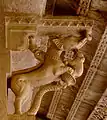Gajasimha
The gajasimha or gajasiha (from Sanskrit: gaja+siṃha / Pali: gaja+sīha) is a mythical hybrid animal in Hindu mythology, appearing as a sinha or rajasiha (mythical lion) with the head or trunk of an elephant. It is found as a motif in Indian and Sinhalese art,[1] and is used as a heraldic symbol in some Southeast Asian countries, especially Cambodia and Thailand. In Siam (pre-modern Thailand), the gajasimha served as the symbol of the kalahom, one of the king's two chief chancellors. It appears as a supporter in the coat of arms of Siam, in use from 1873 to 1910, and the royal arms of Cambodia, officially adopted in 1993.

Gajasimha sculpture, Museum of Cham Sculpture, Danang, Vietnam
Gallery
 Ivory throne leg, Eastern Ganga dynasty
Ivory throne leg, Eastern Ganga dynasty Architectural motif, Gwalior Fort, Madhya Pradesh, India
Architectural motif, Gwalior Fort, Madhya Pradesh, India Lintel detail from Prasat Prei Kmeng, Siem Reab, Cambodia
Lintel detail from Prasat Prei Kmeng, Siem Reab, Cambodia Royal arms of Cambodia
Royal arms of Cambodia.svg.png.webp) Coat of arms of Siam
Coat of arms of Siam Seal of the Minister of Defence, Siam
Seal of the Minister of Defence, Siam Door painting, Wat Arun, Thailand
Door painting, Wat Arun, Thailand Statue, Ministry of Defence, Thailand
Statue, Ministry of Defence, Thailand Royal crematorium of King Bhumibol Adulyadej, Thailand
Royal crematorium of King Bhumibol Adulyadej, Thailand
References
| Wikimedia Commons has media related to Gajasimha. |
- Bane, Theresa (2016). Encyclopedia of beasts and monsters in myth, legend and folklore. McFarland. p. 132. ISBN 9780786495054.
This article is issued from Wikipedia. The text is licensed under Creative Commons - Attribution - Sharealike. Additional terms may apply for the media files.